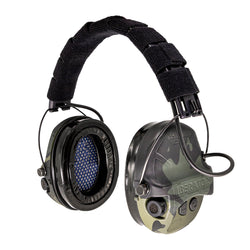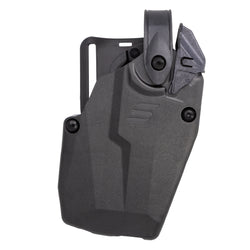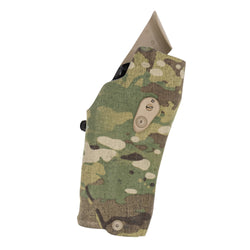Few things are as serotonin-inducing as spending a little time with Mother Nature. Many of us outdoorsy folk like to get away from the hustle and bustle of modern society and recharge our moral, social, and spiritual batteries in the backcountry.
There’s just something uniquely wholesome and calming about hiking along a riverside trail and listening to nothing but the sound of the wind in the trees, the birds chirping, squirrels foraging in fallen leaves, and the trickle of cold Missouri spring water.

I think Henry David Thoreau put it best in Chapter 5 of his Walden memoir. If you haven’t yet, be sure to give it a read.
The Raw Power of Nature
Mother Nature is no pushover, and part of her raw beauty and indescribable sense of awe includes exposure, vulnerability, and inherent risks that can (and will) remind you of just how fragile and insignificant human life is.
Fail to bring enough water, and the sweltering heat and humidity will leave you more dehydrated than shriveled-up sun-dried tomatoes. Improper footwear and poorly planned clothing choices are the leading causes of broken ankles, poison ivy rashes, venomous snake bites, and painful sunburns when hiking, biking, camping, or otherwise “natureing.”
And encounters with foraging black bears, territorial mountain lions, and protective deer (as well as elk or moose) are not uncommon. After all, you’re kind of on their turf.
Two-legged creatures (sometimes called “humans”), too, can be the worst predators and backwoods trail threats of all.

That said, staying strapped while embarking on backcountry adventures is advisable. Always. As an avid mountain bike and hiking enthusiast, and having been raised in the sticks, I never hit the trails without a sidearm, usually my 1911 but sometimes a Glock 17, and a knife.
And while I’ve never (thankfully) had to use my sidearm to ward off some big game predator, I never step foot on a trail without it. It’s just survival.
Let’s discuss.
The Choice of Weapon
Your choice of weapon should depend solely on your climate and locale, I think. It’s one of those decisions where one-size-fits-all advice tends to fall apart pretty quickly once you factor in regional wildlife, terrain, and weather conditions.
The handgun you carry while taming the desert environs of Arizona probably isn’t the same one you’ll want when threading through thick timber of the Smokies down south or crisscrossing the river valleys of the Potomac.
On the trails of Northwestern Missouri, the Ozark hills, and Mark Twain National Forest, I typically like to carry my 1911 chambered in .45 ACP.

It’s a familiar platform that’s more than proven itself to be capable of dispatching the more common threats one might encounter out here, like venomous “nope ropes,” mountain lions, bobcats, and the very rare black bear.
The big, slow-moving .45 might not be the most modern backcountry choice, but it’s more than enough for what I’m likely to face in this part of the country, and I shoot it well.
No Universal Option
In other places, though, my choice of sidearm would likely change. If I were hiking in northern grizzly country, I’d want something like a 10mm Auto or a stout .44 Magnum revolver. Something big and scary, capable of warding off something bigger and scarier… there’s a reason I wouldn’t hike alone out there.
In the thick southern swamplands of the south, on the other hand, a Glock 17 with multiple 17-round magazines might be the smarter option.
You catch my drift, right?
The point is, your sidearm should be as much a product of your environment as your choice of footwear or your pack. And more importantly, remember that confidence and competence with your sidearm matter far more than your choice of chambering when things go sideways.
Carry Options
From your choice of sidearm to your holster setup, carrying in a remote, rugged adventure environment is very different than urban carry. You’ll carry those larger revolvers and full-size semi-auto behemoths (like my aforementioned Government 1911) in place of the smaller subbies you’re used to carrying around town.
And you’re going to carry in positions not typically preferred for everyday carry. That trusty appendix or strong-side IWB holster you rely on for daily errands just doesn’t make sense when you’re navigating around fallen trees or large boulders, hauling a loaded-down day pack, or working around layered cold-weather clothing.
Chest Holsters
While I might typically carry a Hellcat in a Safariland Schema inside-the-waistband holster as my everyday carry, I usually prefer my 1911 in a chest holster while I’m out taming backcountry trails on my two-wheeled Trek steed.

A quality chest holster keeps the gun accessible and easy to reach when—not if—I encounter some territorial 4-legged predator or slithering serpent. It also keeps the firearm clear of brush and gear straps, which can create snag hazards or slow you down.
Further, chest holsters ride securely against your torso and move with your body, so you’re not constantly worrying about your gun getting hung up, buried under layers of clothing, or bashing against rocks when you inevitably slip or take a little bit of a tumble.
And for those running larger revolvers or full-size handguns like my 1911, a well-made chest holster also distributes the weight better than a hip rig, reducing fatigue during long hikes or rides.
Shoulder Holsters
If I’m setting up camp down in the Ozark hills in mid-October, I’ll opt for a shoulder holster. It rides well under a jacket and keeps the gun out of the way while still accessible from a seated position by the fire or while lounging around camp.
Plus, there’s something about carrying a 1911 or some big-bore revolver that gives you a bit of a confidence boost.
The point I’m trying to make here is that adventure carry, as I call it, is unique. Your carry options are typically going to be a big departure from the more common/popular IWB setups most folks default to for everyday carry.
This is due to the emphasis on speed over concealment, as well as the practical need for larger, harder-hitting guns in places where run-ins with four-legged threats (in addition to two-legged spooks) are a real possibility.
Final Thoughts
At the end of the day, getting outside and reconnecting with the natural world is one of the most rewarding things you can do for your body, mind, and soul.
But nature can be scary sometimes. It’s beautiful out there, absolutely. However, it’s also untamed and, occasionally, unforgiving.
For many of us, that’s part of the appeal. But there’s a definite sense of responsibility that goes with it.
You need to be smart, prepared, and realistic about the potential risks involved in backcountry adventuring. This includes packing the right gear, knowing your terrain, and carrying a capable sidearm. What you carry and how you carry it should be tailored to your environment and situation, not the latest tactical fad on social media.
The gun you’d carry in the city isn’t necessarily the best choice when a black bear decides you’re a tad too close to her cubs, or some territorial mountain lion decides you’ve encroached on his turf.
Ultimately, backcountry, or “adventure” carry, as we called it, is more about confidence, competence, and common sense than anything else. Defend yourself if you must, but don’t venture out looking for a fight.
Know your surroundings, trust your gut, and above all else, respect Mother Nature. It’s beautiful out there, and it deserves our utmost respect.









